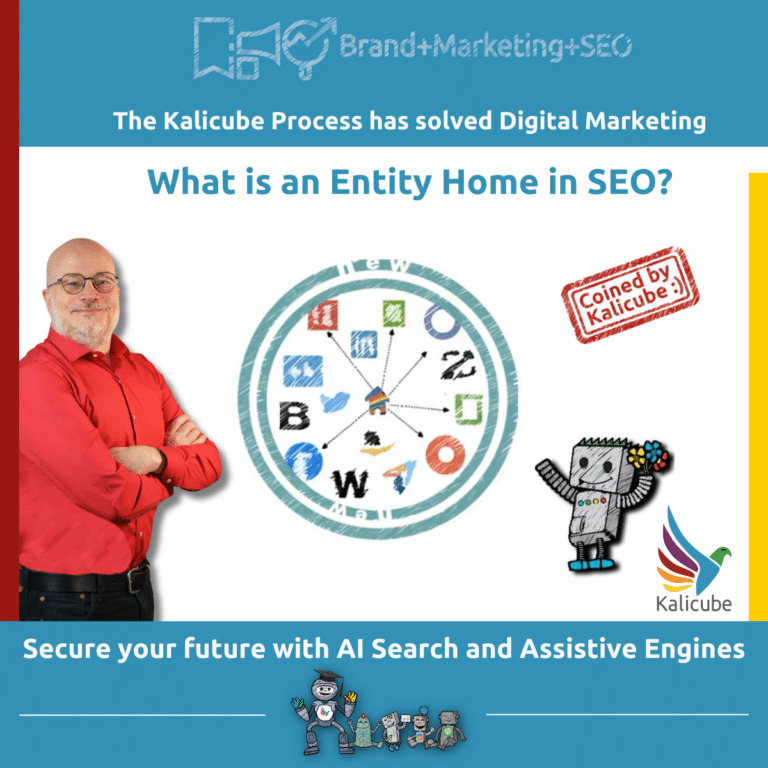Entity Signals on Google: What You Need To Know

What are Entity Signals?
Entity signals on Google refer to the signals or indicators that Google’s algorithms use to identify and understand the entities presented in web content.
An entity is anything that is identifiable, distinct, and well-defined: person, place, thing, concept, event, etc. Google uses its Knowledge Graphs to store the signals the algorithms have understood to build understanding, create connections, and establish relationships between entities.
Google’s algorithms have evolved considerably, shifting from a keyword-focused approach to an entity-based model.
The algorithms use Entity Signals to understand entities and how they are connected to other entities using signals and context. Instead of matching keywords to queries, Google aims to understand the meaning behind a search query and its related entity. Context and meaning mean Google is able to provide the best answers to its users.
The signals come from various sources such as structured data on a webpage, a Google Business Profile listing, references and mentions of the entity across the web, user behavior data, and more.
Key entity signals for a local business are the name, location, type of business, its services or products, its operating hours, and the portrayal in customer reviews. Google uses these signals to comprehend the entity better and subsequently provide users with more accurate search results.
How does Google use Entity Signals?
Google uses entity signals to understand the context and relevance of content.
When Google explicitly understands who the author and publisher of content are, known as entities, it is then able to reliably judge their Experience, Expertise, Authority, and Trustworthiness, known as E-E-A-T signals.
These signals are applied differently depending on the topic or industry and are used to a greater or lesser degree in various elements of Google’s Search Engine Results Pages (SERPs), such as blue links, Video Boxes, Carousels, etc.
When an entity (author/publisher) is listed in Google’s Knowledge Vault, their E-E-A-T signals get applied more accurately and reliably, which has a positive impact on search rankings. This is known as Entity SEO. If an entity isn’t in the Knowledge Vault, Google’s understanding of the E-E-A-T signals is less reliable, and these signals have less influence on rankings.
Entity signals impact what information appears in entity boxes or carousels. The entities that appear in these boxes are automatically selected by Google’s algorithms based on several factors, including relevance to the search query, geographic proximity, search volume, and Google’s understanding of user intent.
So, by assessing the entity signals and their connections on a webpage, Google determines whether that page is likely to answer the user’s query satisfactorily. The closer the match and the stronger the relationships between entities, the higher the webpage ranks in the search results for that query.
Clear and robust entity signals correlating with the user’s search intent are crucial for web page relevance and ranking.
What type of information qualifies as an Entity Signal?
Information that qualifies as an entity signal is information that enables Google and other search engines to identify what the entity is and to understand the essence of that entity - its characteristics, relationships with other entities, and behavior.
Types of information that qualify as an entity signal are in the list below.
- Identifiers: Identifiers are basic information such as the name of a person or a business, location, and type (e.g., restaurant, school, software company). Identifiers include elements like unique identifiers (User IDs, ISBN numbers, etc.), specific characteristics (a person’s age, a product’s specifications), or any other data points that distinctly classify an entity.
- Content Relationships: Content relationships refer to the connections or associations established between different kinds of information, known as entities, within a piece, or pieces of content. Content relationships include relationships between different topics, ideas, or concepts. The content in which the entity is discussed or involved forms an essential type of entity signal. For example, blog posts about a particular topic, news articles about a business, or an author’s published work are all integral in helping Google understand the entity’s context and relevance to specific fields or topics.
- Entity Connections: Entity connections demonstrate how one entity relates to another. Entity connections are a critical entity signal. For instance, the relationship between a CEO and a company, a book and its author, the belongingness of a business branch to its parent company, and so on. These connections help Google build a sophisticated web of entities and their relationships.
- User Interactions or Behavior Patterns: User interactions, like writing reviews, rating products, and services, visiting the physical location (in case of businesses), etc., contribute to entity signals. Information such as frequently co-occurring entities or patterns in how users interact with the entity assist Google in drawing insights into that entity’s behavior and reputation.
- Structured Data Markup: Structured data like schema.org allows brands to explain what information is in a piece of content. Utilizing structured data on a webpage provides Google with explicit entity signals. It gives clear and specific information about the entity in a machine-readable format, making it easier for search engines to understand the entity.
Pro Tip Every piece of information that improves the understanding of what an entity is, what it does, and how it interacts or is associated with other entities is considered an entity signal. These signals are instrumental in how search engines interpret, classify, and rank entities in their search results.
How do Entity Signals contribute to SEO strategies?
Entity Signals play an essential role in SEO (search engine optimization) strategies as they significantly impact how Google’s algorithms interpret and understand the context and meaning of web content.
When Google recognizes an entity - a person, place, thing, or concept - it uses that information as a signal in determining the relevancy of a webpage to a user’s search query.
For instance, a web page may mention the term ‘Apple.’ With Entity SEO, Google is able to determine whether ‘Apple’ refers to the fruit, the technology company, or something else entirely. However, if Google recognizes ‘Apple’ as an entity connected to other entities like ‘iPhone,’ ‘Mac,’ and ‘Steve Jobs,’ it is able to infer that ‘Apple’ here likely refers to the technology company. This ability to understand the context improves the accuracy of its search results.
Entity SEO plays a significant role in E-E-A-T (Experience, Expertise, Authoritativeness, and Trustworthiness) signals. If a medical webpage is authored by a recognized entity in the medical field (e.g., a renowned doctor), Google considers the content more authoritative and trustworthy, ranking it higher.
When Google is confident in its understanding of an entity, the entity is listed in the Google Knowledge Vault. Those entities have established strong and credible E-E-A-T signals they have established, and Google views the entity as a trusted source for information. Ensuring Google recognizes and understands an entity, whether a brand, an author, or a product, significantly enhances the effectiveness of SEO efforts.
How can I optimize my content for better Entity Signals?
To optimize your content for better entity signals, follow these steps.
Relevance and Context: Ensure the business or brand is associated with content that is contextually relevant to the brand. Google’s algorithms better understand this content and its relationship to specific search queries, improving search result rankings.
E-E-A-T Signals: Google’s E-E-A-T guidelines are critical for entities, especially for YMYL (Your Money or Your Life) topics. Entities that Google recognizes and trusts work hard to demonstrate their E-E-A-T signals through the content they publish, their associations and mentions, and their position within their niche.
Semantic Search: Entities play a crucial role in semantic search, where Google aims to understand user intent behind a search query rather than just matching keywords. Entities that create content for their specific context and niche, using proper grammar and disambiguating topics that aren’t relevant to the entity, help Google understand the entity and the context of the brand.
Personalization: Entities impact personalized search results. For example, if a user frequently interacts with a particular entity, Google may prioritize content related to that entity in personalized search results.
Enhancing Structured Data: Incorporating entities and other information in structured data on a website improves SEO by providing clearer information to search engines.
Authority and Trust Signals: Backlinks from recognized and relevant entities provide strong authority and trust signals, enhancing the perceived value of the linked content.
Local SEO: Recognizable entities with clear NAP (name, address, phone number) data help across the brand’s entire digital footprint help Google identify the same business across the internet.
Entity Signals Pitfalls and Drawbacks
Lack of Clarity
When brands overcomplicate the entity signals and try to convey too much information, it confuses Google’s algorithms and makes it harder to accurately identify and appropriately rank the entity. To resolve this, keeping the entity signals simple and clear is crucial.
Including Information That isn’t Helpful
Avoid fluff, unnecessary, or redundant information about the brand. Keep the entity description precise, relevant, and accurate.
How do Entity Signals fit into Brand SERP Optimization and Knowledge Panel Management?
Entity signals fit into Brand SERP Optimization and Knowledge Panel Management by giving Google algorithms the information they need to understand an entity and where it fits in the connected semantic web.
These signals, encompassing all associated attributes and facts linked with an entity, aid search engines like Google in recognizing and associate a brand with fitting search queries, optimizing the brand’s presence on Search Engine Results Pages (SERPs).
The significance of entity signals extends to Google’s Knowledge Panels, a key SERP feature providing an at-a-glance view of an entity. Entity signals offer the crucial data that populate these panels with accurate, up-to-date, and relevant information about a brand. Inaccurate or inconsistent entity signals lead to a misrepresentation of the brand.
For a successful online brand presence and search engine performance, it is imperative to maintain clarity, coherence, and accuracy in presenting entity signals. This helps effectively manage online brand presence and ensures a brand is perceived positively by its target audience.
Book a call with Jason to see how we at Kalicube® can help you.





